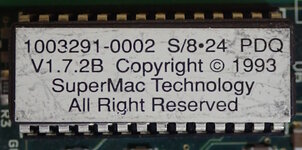jmacz
Well-known member
OK - that fixed the ROM issue then.
Yup, the first 1.27 image works. Thanks!
OK - that fixed the ROM issue then.






The 24 IV 3.1 ROM works for me. Thanks!
The Spectrum 8 24 PDQ ROM.. these names are so confusingI tried it in my Spectrum 24 PDQ and didn't work, then realized it's meant for the 8*24 PDQ.
Same here.Even though @MacOSMonkey has taken the time to provide the inside scoop multiple times, I still get confused as to variety of boards SuperMac produced. They certainly were prolific (even with just badging).
Oh, nice! Didn't realize those cards had been understood that well already. From the code, it looks like the acceleration is limited to rectangle fill and rectangle copies... I guess the NuBusFPGA isn't too far behind thenthe Spectrum PDQ's accelerator which we already fully support.
Yes, there's probably some "interesting" combinations of behavior with bus mastering on NuBus, in particular to support block transfers;.. I did manage to make it work at hardware level (to some extent) in the NuBusFPGA, but not do anything useful with it for now. I have issues in the virtual <-> physical mapping, I think.The main issues for all NuBus developers usually had to do with cards that were bus masters
And a bit beyond I probably,Apple's 8*24GC (...) cool design and it pushed NuBus to the limit.
Hehe, that would yesthe base address was decoded as $FB300000 instead of $FBB00000, which caused problems
Rectangle shapes - but including blitting, fill, etc.The acceleration is not just limited to rectangles.
It still isn't, in fact with the lost knowledge, it's probably harder. No more support from Apple and no more poaching experienced engineers from another company...Also, in 1989 (at least), it was a non-trivial task to disassemble, map, patch and/or optimize QD32. But maybe others have done some of that work now and made it public.

https://macintoshgarden.org/apps/bug-pickles-pickles-xaTo the best of my knowledge, the only source code publicly available to do that kind of thing is in my acceleration INIT. If someone knows another, I want to know!
No, the 8*24 GC was the one using the AM29000 - I use a VexRiscv, a highly configurable RISC-V core. I don't think there's a recreation of the AM29K for FPGAs or otherwise, they were not used in any popular computer or game console that I know of. But I didn't check thoroughly for things other than 68K.It's interesting that you are using an am29K. I think SuperMac's ProofPositive RIP engine product was RISC/am29K-based.
As far as i could tell from the available code, the Pickles only "accelerated" things like pan-and-scan - basically you just need to change the area of memory displayed on screen from a larger in-VRAM area. I didn't see any trap replacement or potential drawing code in the source code when I looked at it to figure out how to do the declaration rom (mostly the video drivers) and interfacing between ASM and C.https://macintoshgarden.org/apps/bug-pickles-pickles-xa
There is acceleration code in those archives. Code available for both firmware and drivers.
